Tupolev Tu-154 Videos
|
Loading...
|
|
|
2nd Video Clip Info |
Tupolev Tu-154
Tu-154
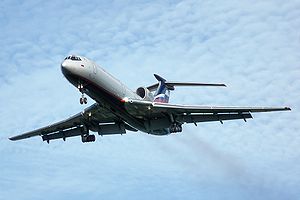
Picture - Aeroflot Tupolev Tu-154M
Role: Airliner
National origin: USSR
Manufacturer: Tupolev
First flight: 4 October 1968
Introduced: 9 February 1972
Status: In service
Primary users: UTair
KMV
Iran Air Tours
Produced: 1968-2010
Number built: 1015
Unit cost: 45 Million USD 2008
Variants: Tupolev Tu-155
Iran Air Tours
The Tupolev Tu-154 (Russian: ТÑполев ТÑ-154) (NATO reporting name: Careless) is a Soviet medium-range trijet airliner designed in the mid 1960s. As the mainstay 'workhorse' of Soviet and Russian airlines for several decades, it serviced over a sixth of the world's landmass and carried about half of all passengers flown by Aeroflot and its subsidiaries (137.5 million/year or 243.8 billion passenger km in 1990). Having been exported and operated by 17 non-Russian airlines and a number of air forces, it remained the standard domestic route airliner of Russia and former Soviet states until the mid 2000s.
With a cruising speed of 975 km/h, the Tu-154 is one of the fastest civilian aircraft in operation and has a range of 5280 kilometers. Capable of operating from unpaved and gravel airfields, it is used in the extreme Arctic conditions of Russia's northern territories where facilities can be basic. With a service life of 45,000 hours (18,000 cycles) but capable of 80,000 hours with upgrades, it is expected to continue operations until 2016, although noise regulations have seen services to western Europe and other areas restricted. In January 2010, Russian flag carrier Aeroflot announced the retirement of its Tu-154 fleet after 40 years with the last flight operated by Aeroflot Flight 736 from Ekaterinburg to Moscow on 31 December 2009.
Since 1968 there have been 37 fatal incidents involving the Tu-154, most of which were caused by factors unrelated to the aircraft. This number is not considered unusual given its specifications, number in operation, years in service, and heavy use in demanding conditions.
Development
The Tu-154 was developed to meet Aeroflot's requirement to replace the jet-powered Tu-104 and the Antonov An-10 'Ukraine' and the Ilyushin Il-18 turboprops. The requirements called for either a payload capacity of 16-18 tons (35,270-39,680 lb) with a range of 2,850-4,000 km (1,770-2,480 mi) while cruising at a speed of 900 km/h (559 mph), or a payload of 5.8 tons (12,790 lb) with a range of 5,800-7,000 km (3,600-4,350 mi) while cruising at 850 km/h (528 mph). A take-off distance of 2,600 m (8,530 ft) at maximum take-off weight was also stipulated as a requirement. Conceptually similar to the British Hawker Siddeley Trident, which first flew in 1962, and the Boeing 727, which first flew in 1963, the medium-range Tu-154 would be marketed by Tupolev at the same time as Ilyushin was marketing the long-range Ilyushin Il-62. The Soviet Ministry of Aircraft Industry chose the Tu-154 as it incorporated the latest in Soviet aircraft design and best met Aeroflot's anticipated requirements for the 1970s and 1980s.
The first project chief was Sergey Yeger but in 1964, Dimitriy S. Markov assumed that position. 11 years later in 1975 he turned it over to Aleksandr S. Shengardt.
The Tu-154 first flew on 4 October 1968. Commercial service began in February 1972, and there is still limited production of the 154M model as of January 2009, (photo link) despite previous announcements of the end of production in 2006. 1015 Tu-154s have been built, 214 of which are still in service as of 14 December 2009.
Design
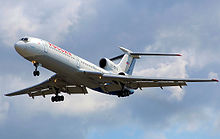
Picture - Tu-154M of Rossiya
The Tu-154 is powered by three rear-mounted low-bypass turbofan engines arranged similarly to those of the Boeing 727, and is slightly larger than its American counterpart. Both the 727 and the Tu-154 use an S-duct for the middle (Number 2) engine. The original model had Kuznetsov NK-8-2, while the Tu-154M has Soloviev D-30KU-154 engines. All Tu-154 aircraft models have a higher thrust-to-weight ratio than that of the 727 - this gives them superior performance, although at the expense of poorer fuel efficiency, which became an important factor in later decades as fuel costs grew.
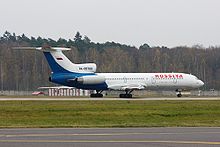
Picture - Tu-154M on departure at Domodedovo airport
The cabin of the Tu-154, although of the same six-abreast seating layout, gives the impression of an oval interior, with a lower ceiling than is common on Boeing and Airbus airliners. The passenger doors are also smaller than on its Boeing and Airbus counterparts. Furthermore, luggage space in the overhead compartments is very limited.
Like the Tupolev Tu-134, the Tu-154 has a wing swept back at 35 degrees at the quarter-chord line. The British Hawker Siddeley Trident has the same sweepback angle, while the Boeing 727 has a slightly smaller sweepback angle of 32 degrees.
The wing also has Anhedral (downward sweep) which is distinguishing feature of Russian low-wing airliners designed during this era. Most Western low-wing airliners such as the contemporary Boeing 727 have Dihedral (upward sweep).
Like many other Soviet-built airliners, the Tu-154 has an oversized landing gear enabling it to land on unpaved runways, once common in rural areas of the Soviet Union. The aircraft has two six-wheel main bogies fitted with large low-pressure tires that retract into pods extending from the trailing edges of the wings (a common Tupolev feature), plus a two-wheel nose gear unit. Soft oleo struts (shock absorbers) provide a much smoother ride on bumpy airfields than most airliners, which only very rarely operate on such poor surfaces.
The passenger cabin accommodates 128 passengers in two-class layout and 164 passengers in single-class layout, and up to 180 passengers in high-density layout. The layout can be modified to what is called a winterized version where some seats are taken out and a wardrobe is installed for passenger coats.
The original requirement was to have a 3 man flight crew - Captain, First Officer and Flight Engineer - as opposed to 4 or 5 man crew on other Soviet airliners. A fourth crew member, a navigator, is usually also present in the former Soviet Union, due to union rules. Navigators are no longer trained and this profession will become obsolete with the retirement of older Soviet planes.
The plane's avionics suite, for the first time in the Soviet Union, is built to American airworthiness standards. The latest variant (Tu-154M-100, introduced 1998) includes an NVU-B3 Doppler navigation system, a triple autopilot, which provides an automatic ILS approach according to ICAO category II weather minima, an autothrottle, a Doppler drift and speed measure system (DISS), "Kurs-MP" radio navigation suite and others. Modern upgrades normally include a TCAS, GPS and other modern systems, mostly American or EU-made.
Early versions of the Tu-154 cannot be modified to meet the current Stage III noise regulations and are banned from flying where those regulations are in force, such as Europe. The Tu-154M may use hush kits to meet Stage III and theoretically Stage IV. However current European Union regulations forbid the use of hush kits to meet Stage IV. The Tu-154M would need to be re-engined to meet Stage IV within the EU, an extensive and potentially expensive upgrade.
Variants
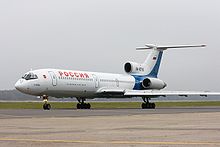
Picture - Rossiya Airlines Tu-154M
Tu-154 Tu-154 production started in 1970, while first passenger flight was performed at 9 February 1972. Powered by Kuznetsov NK-8-2 turbofans, it carried 164 passengers. About 42 were built. Tail numbers from 85006 to 85055.
Tu-154A The first upgraded version of the original Tu-154, the A model, in production since 1974, added center-section fuel tanks and more emergency exits, while engines were upgraded to higher-thrust Kuznetsov NK-8-2U. Other upgrades include automatic flaps/slats and stabilizer controls and modified avionics. Max. take-off weight - 94,000 kg (207,235 lb). There were 15 different interior layouts for the different domestic and international customers of the airplane, seating between 144 and 152 passengers. The easiest way to tell the A model from the base model is by looking at the spike at the junction of the fin and tail; this is a fat bullet on the A model rather than a slender spike on the base model. Tail numbers from 85056 to 85119.
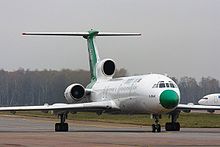
Picture - Turan Air Tu-154M
Tu-154B As the original Tu-154 and Tu-154A suffered wing cracks after only a few years in service, a version with a new, stronger wing, designated Tu-154B, went into production in 1975. It also had an extra fuel tank in fuselage, extra emergency exits in the tail, and the maximum take-off weight grew to 98,000 kg (216,053 lb). Also important to Aeroflot was that the increased passenger capacity led to lower operating costs. As long as the airplane had the NK-8-2U engines the only way to improve the economics of the airplane was to spread costs across more seats. The autopilot was certified for ICAO Category II automatic approaches. Most previously built Tu-154 and Tu-154A were also modified into this variant, with the replacement of the wing. Max. take-off weight increased to 96,000 kg (211,644 lb). 111 were built. Tail numbers ran from 85120 to 85225.
Tu-154B-1 Aeroflot wanted this version for increased revenue on domestic routes. It carried 160 passengers. This version also had some minor modifications to fuel system, avionics, air conditioning, landing gear. 64 were built from 1977-1978. Tail numbers from 85226 to 85294.
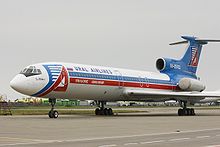
Picture - Ural Airlines Tu-154B-2
Many variants of this airliner have been built. Like its western counterpart, the 727, many of the Tu-154s in service have been hush-kitted, and some converted to freighters.
Tu-154B-2 A minor modernization of Tu-154B-1. The airplane was designed to be converted from the 160 passenger version to a 180 passenger version by removing the galley. The procedure took about two and a half hours. Some of the earlier Tu-154B modified to that standard. Max. take-off weight increased to 98,000 kg (216,053 lb), later to 100,000 kg (220,462 lb). 311 aircraft were built, including VIP versions. Tail numbers (new-built) from 85295 to 85605. A few of them are still in use.
Tu-154S The Tu-154S is an all-cargo or freighter version of the Tu-154B, using a strengthened floor, and adding a forward cargo door on the port side of the fuselage. The airplane could carry 9 Soviet PAV-3 pallets. Max. payload - 20,000 kg (44,092 lb). There were plans for 20 aircraft, but only nine aircraft were converted; two from Tu-154 model and seven from Tu-154B model. Trials were held in the early 1980's and the aircraft was authorized regular operations in 1984. By 1997 all had been retired. Tail numbers: 85019 (Tu-154), 85037 (Tu-154), 85060, 85062, 85063, 85067, 85081, 85084, 85086.
Tu-154M The Tu-154M and Tu-154M Lux are the most highly upgraded version, which first flew in 1982 and entered mass production in 1984. It uses more fuel-efficient Soloviev D-30KU-154 turbofans. Together with significant aerodynamic refinement, this led to much lower fuel consumption and therefore longer range, as well as lower operating costs. The aircraft has new double-slotted (instead of triple-slotted) flaps, with an extra 36-degree position (in addition to existing 15, 28 and 45-degree positions on older versions), which allows reduction of noise on approach. It also has a relocated auxiliary power unit and numerous other improvements. Manufacture continued through 2006, and there is still limited manufacturing as of January 2009.(photo link) Max. take-off weight increased first to 100,000 kg (220,462 lb), then to 102,000 kg (224,872 lb). Some aircraft are certified to 104,000 kg (229,281 lb). Tail numbers are 85616 (prototype), production aircraft from 85606 and on (except 85804, which is re-imported Tu-154B-2). About 320 were manufactured. Mass production ended in 2006. No new airframes have been built since the early 1990s, and production since then has involved assembling airplanes from components on hand. This is the most widely used version in the former Soviet states.
Tu-154M-LK-1 Cosmonaut Trainer. This was a Salon VIP aircraft modified to train cosmonauts to fly the Buran reusable spacecraft, the Soviet equivalent of the US Space Shuttle. The Tu-154 was used because the Buran required a steep descent, and the Tu-154 was capable of replicating that. The cabin featured trainee work-stations, one of which was the same as the Buran's flightdeck. The forward baggage compartment was converted into a camera bay, because the aircraft was also used to train cosmonauts in observation and photographic techniques.
Tu-154M-ON Monitoring Aircraft Germany modified one of the Tu-154s it had on hand from the former East German Air Force into an observation airplane. This airplane was involved with the Open Skies inspection flights. It was converted at the Elbe Aircraft Plant (Elbe Flugzeugwerke) at Dresden-Klotzsche, and flew in 1996. After two dozen monitoring missions, it was lost in a mid-air collision in 1997.
The Russians also converted a Tu-154M to serve as an Open Skies Monitoring aircraft. They used the Tu-154M-LK-1, and converted it to a Tu-154M-ON. When the aircraft is not flying over North America, it is used to ferry cosmonauts around. The Chinese are also believed to have converted one Tu-154 to an electronic countermeasures aircraft.
Tu-154M-100 Design of this variant started in 1994, but the first aircraft were not delivered until 1998. It is an upgraded version with western avionics, including the Flight Management Computer, GPS, EGPWS, TCAS, and other modern systems. The airplane could carry up to 157 passengers. The cabin featured an automatic oxygen system and larger overhead bins. Only three were produced, as payment of debts owed by Russia to Slovakia. Three aircraft were delivered in 1998 to Slovak Airlines, and sold back to Russia in 2003.
Operators
Civil operators
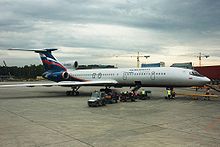
Picture - Aeroflot Tu-154M
As of 10 June 2010 a total of 200 Tupolev Tu-154 aircraft (all variants) remained in airline service. Major operators include:
Azerbaijan Airlines has stopped tu-154 models since 2008.
Former civil operators
Past and present operators: Abakan Air Enterprise, Aerokuznetsk, Aeroservice Kazakhstan, Aerotrans, Aerovolga, Air Georgia, Air Great Wall, Air Savari, AJT, Amur Avia, Asian Star, Aviaprad, Aviaprima, AVL Arkhangel, Balkan Holidays Air, Baltic ExpressBarnaul Air, Bratsk Air, Chelal, Chernomoravia, China Glory, China Xinjiang, Chita Avia, Diamond Sakha, East Line, Elk Estonian, Georgia Air Prague, Gomel UAD, Imair, Iron Dragonfly, Khabarovsk Aero, Latpass, Macedonia Airservice, Moscow Airways, Murmansk Air, Nizhny Novgorod Air, Orbi Georgian, Sakha Avia, Surgut Avia, Tomsk Air, Transeuropean, Turanair, Tyumen Airlines, Ulyanovsk Airlines, Vitair.
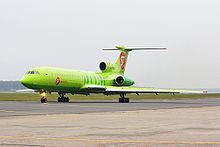
Picture - S7 Airlines Tu-154M
Albania
Albanian Airlines
Azerbaijan
Azerbaijan Airlines
Bulgaria
Air Via
Bulgarian Air Charter
Balkan Bulgarian Airlines
Hemus Air
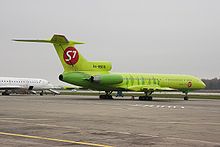
Picture - S7 Airlines Tu-154M
People's Republic of China
Civil Aviation Administration of China
China Northwest Airlines
China Southwest Airlines
China United Airlines
Sichuan Airlines
Cuba
Cubana
Czechoslovakia
CSA Czech Airlines
East Germany
Interflug
Egypt
Egyptair
Georgia
Transair Georgia
Hungary
Malev Hungarian Airlines
Transair Georgia
Iran
Bon Air
Kish Air
Mahan Air
Kazakhstan
Atyrau Airways
Libya
Libyan Arab Airlines
Macedonia
Avioimpex
Moldova
Aerocom
Air Moldova
Mongolia
MIAT Mongolian Airlines
Nicaragua
Aeronica
Poland
LOT Polish Airlines
Romania
TAROM
Russia
Abakan-Avia
Air Volga
Airlines 400
ALAK (airline)
Avial (airline)
Baikal Airlines
BAL Bashkirian Airlines
Continental Airways
Enkor
KrasAir
KD Avia
Kuban Airlines
Mavial Magadan Airlines
Nordavia
Omskavia
Perm Airlines
Polet Airlines
Pulkovo Aviation Enterprise
Rossiya (airline)
Russian Sky Airlines
S7 Airlines
Samara Airlines
Sibaviatrans
Slovakia
Air Transport Europe
Slovak Airlines
Soviet Union
Aeroflot
Syria
Syrianair
Turkey
Active Air
Greenair
Holiday Airlines
United Arab Emirates
Daallo Airlines
Ukraine
Air Ukraine
Odessa Airlines
Military operators
Current
Picture - One of two Polish military VIP transport Tu-154M Lux aircraft from the 36th Special Air Transport Regiment, at Warsaw Frederic Chopin Airport. The other one crashed at Smolensk North Airport on April 10, 2010, killing all on board, including the Polish President.
Bulgaria Bulgarian Air Force People's Republic of China People's Liberation Army Air Force Mongolia North Korea Korean People's Air Force Poland Polish Air Force - 1 Tu-154M in service, 1 Tu-154M crashed in 2010. Russia Russian Air Force Slovakia Slovak Air Force Turkmenistan Military of Turkmenistan - 2 Tu-154B aircraft in service. Ukraine Ukrainian Air Force Uzbekistan
Former
Czechoslovakia Czechoslovakian Air Force (passed on to successor states) Czech Republic Czech Air Force (replaced by Airbus A319CJ) Cuba Cuban Air Force (out of service) East Germany East German Air Force (passed on to FRG) Germany Luftwaffe (1 lost, the other one sold) Soviet Union Soviet Air Force (passed on to successor states)
Incidents and accidents
There have been 67 serious flight incidents with Tu-154s, including 37 hull-losses involving fatalities. Six of those incidents resulted from terrorist or military action (two other war-time hull losses were non fatal) including an accidental missile shootdown by Ukraine, several from poor runway conditions in winter (including one which struck snow ploughs on the runway), cargo overloading by airlines in the lapse of post-Soviet federal safety standards (several cases), and mid-air collisions due to faulty air traffic control or mis-communication. Other incidents have resulted from mechanical problems (two cases prior to 2001), running out of fuel on unscheduled extended route, pilot error, and cargo fires. The Tu-154 is described as having an average (or better than expected) safety record considering its length of service and heavy use in the most demanding conditions.
Specifications
Related development
S-duct
Tupolev Tu-155
Tupolev Tu-204
Comparable aircraft
Boeing 727
Hawker Siddeley Trident
Dmitriy Komissarov, Tupolev Tu-154, The USSR's Medium-Range Jet Airliner, (Hinckley, UK, 2007) ISBN 1-185780-241-1
Living Warbirds: The best warbirds DVD series.
Source: WikiPedia